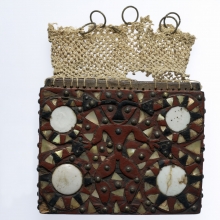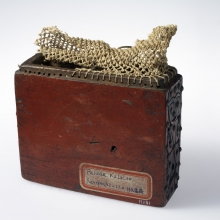TELDAP Collections
| Paiwan Shaman's Box |
This is a box used by the shamans of the Paiwan tribe and referred to as kanepochi or anepochi in that tribe’s native language. These boxes were mostly made from wood. They served as containers for objects used in divination rites. These varied from village to village, but often included a small metal knife or metal strip, bamboo tube, square wood plate, pig skin, pig bones, bark, fruit, seeds, small bottle gourd and pebbles, etc. The knife or metal strip was used to symbolically cut items used during the performing of rites. Seeds represented the beads of the tribal deities and the box itself was considered their throne. During divination rites, the shaman would place a seed on the arc of the bottle gourd and continuously ask the deities a question until the seed stopped moving. Where it stopped represented the answer. According to written records, the bamboo tube contained dried pigskin and pig bones. These represented a whole pig offered as a sacrifice. The wood plate was used for holding offerings and the objects used in the performance of rites. Sometimes, shamans would use fresh banyan or mulberry leaves instead of a wooden plate. Most Paiwan shamans are female, and performing healing rites is one of their most important duties. This shaman’s box measures approximately 21 cm in length, 14 cm in width and 4 cm in height. It is carved with 26 human faces and decorated with 52 brass stud “eyes”. The upper part of the box is made of woven ramie. Straps are connected to this for the shaman to carry the box on the back.
Department of Graphic Communications and Digital Publishing, Shih Hsin University Digital archiving project of the Shung Ye Museum of Formosan Aborigines
|















